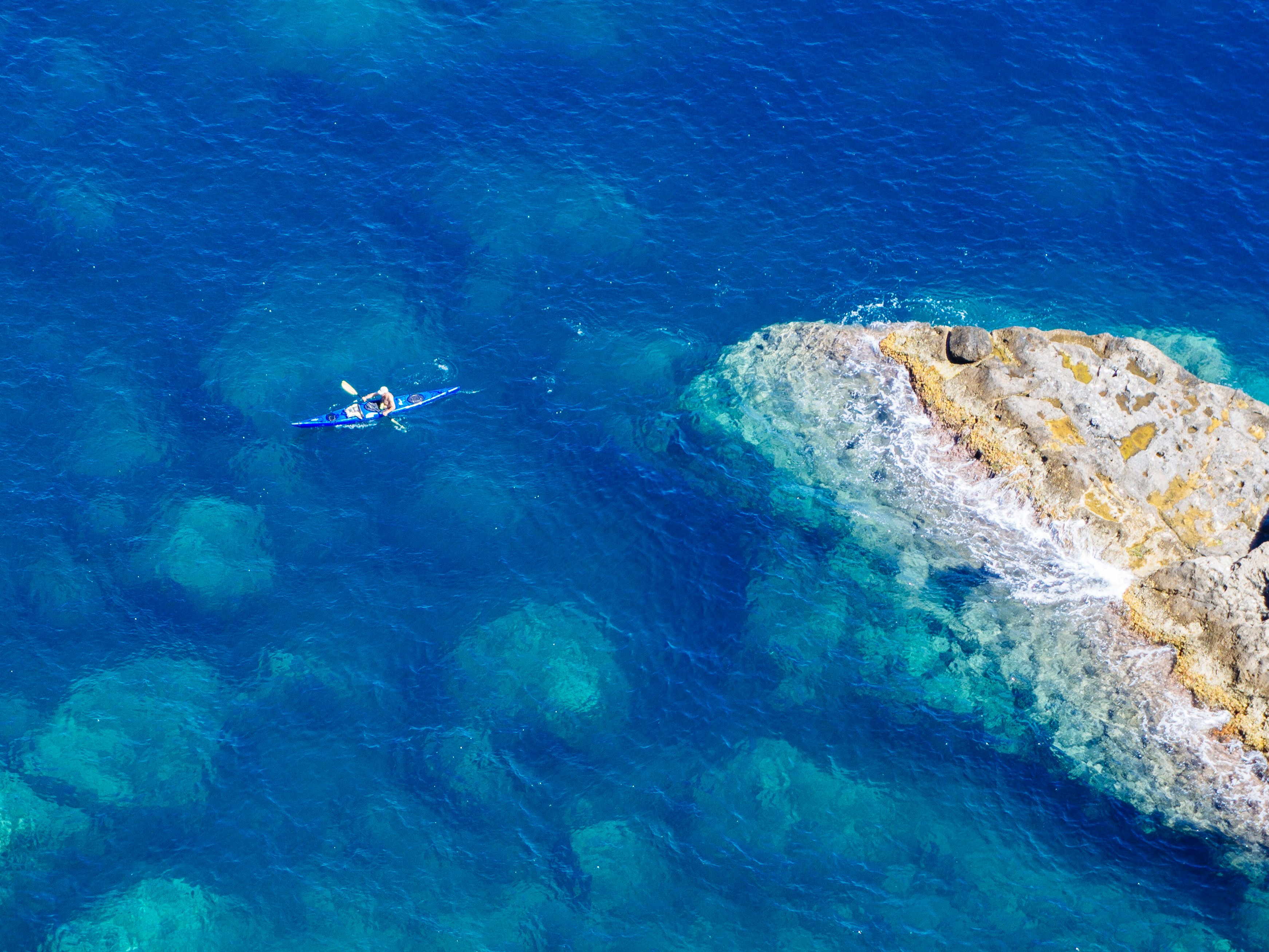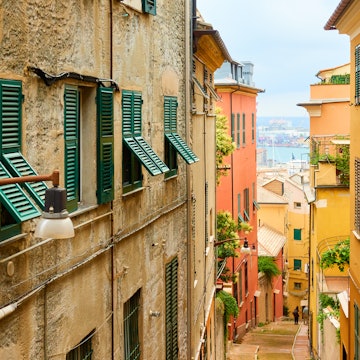

The technicolour coastal harbours of Procida are well worth lingering in. leoks / Shutterstock
Procida has the same tumble of pastel houses, the same boat-speckled harbours, the same bougainvillea-draped streets as Capri – but without the crowds. The Bay of Naples’ smallest island has somehow remained off the tourist trail, bar a flurry of vacationing Neapolitans in August. Come September, the holiday-goers disappear, leaving near-empty volcanic beaches and silent old towns in their wake.
Big-screen appeal, without the pretensions
Gina Lollobrigida, Sophia Loren, Elizabeth Taylor… Procida has been quietly seducing film stars for decades. The Bay of Naples’ best-kept secret, this tiny speck is often bypassed for Ischia or Capri. It doesn’t yield anywhere near the volume of column inches in guidebooks as its better-known siblings, nor anywhere near the number of visitors. That’s the beauty of this unshowy island, just 40 minutes by boat from Naples.
It’s remained gloriously under the radar, despite catching the eye of Anthony Minghella for his 1999 psychological thriller, The Talented Mr Ripley. Scenes were shot in the cobblestoned streets of the 17th-century Marina di Corricella, the island’s oldest fishing village. Ordinarily, this would see skyrocketing prices and hordes of film fans flocking to the spot – not here. The only sign of tourists is RIBs (rigid-inflatable-boats) carting Italian families from their moored boats to the shore for lunch at unassuming trattorias.
Seafood restaurants occupy the traditional fishermen’s houses on the waterfront – originally painted in vivid shades so they could easily be identified from the sea. It’s clearly proved successful: weathered men repair fishing nets on the harbourfront, calling to one another across the water. The jumble of candy-coloured buildings clings to the slopes of a steep hill, crisscrossed with scalatinelli (staircase streets) climbing past sleepy piazzas. Elderly signoras sit in the shade, as the bells ring out from the lemon-yellow church of Santa Maria delle Grazie. It’s easy to imagine Jude Law and Matt Damon striding through the alleys, past flaky facades strung with lines of fluttering laundry.

Off the mass tourism trail
The pace slips down a few gears over Procida’s 1.6 square miles. Tiny buses navigate the island’s narrow streets, crawling slowly behind ambling locals who are in no hurry to reach their destination. It might be faster to walk, although it’s not for the fainthearted. The roads are so slender that locals tuck the wing mirrors in on their cars to avoid damage – but many are still etched with scratches.
Only a handful of hotels are scattered across Procida, mainly due to building regulations preventing overdevelopment. Instead, visitors can rent fishermen’s houses in Marina di Corricella and, at the opposite end of the island, Marina Chiaiolella – the nearest village to the Lido di Procida. This west-facing beach is popular for its sunsets; the one place on Procida that does get busy. Even then, that’s only in August, and mainly with holidaying Neapolitans and a few French tourists paying homage to the protagonist from Alphonse de Lamartine’s novel, Graziella, who falls in love with a fisherman’s daughter on the island. Nonetheless, it’s never so crowded as to be impossible to find a towel-sized patch of charcoal-black sand, and the only wait in restaurants is for waiters to scribble down the catch of the day on chalkboards. Come September, the island belongs to the locals again.
Chiaiolella brims with boutiques, pasticcerie and gelaterie, as well as some excellent seafood restaurants along the waterfront. At the outdoor terrace of Ristorante da Mariano, waiters reel off specials to well-heeled diners – spaghetti ai ricci di mare (spaghetti with sea urchin), insalata di limone (lemon salad), vino di falanghina. Next door, groups of stylish 20- and 30-somethings gather at Ristorante Crescenzo, sharing Neapolitan pizzas washed down with draught beers, as young bar staff dash outside to hug friends parking Vespas.

Deserted beaches and pristine nature
Procida has a natural beauty to rival that of Ischia’s, yet is often overlooked for its bigger, greener sister. But that’s part of its appeal – near-empty beaches with untouched sands. That’s if you can find them. Steep staircases, marked by blink-and-you-miss-them spiaggia (beach) signs, are partially obscured from the street by clouds of bougainvillea. Hidden beneath a tangle of twisted cacti and olive trees, sheer cliff faces crash down to rugged dark sands. Waves drag at the shore and rickety wooden jetties cut across limpid waters. The beaches are pretty much deserted during the week, filling with local families at the weekend.
To the west is Pozzo Vecchio, whose black sands provided the backdrop for 1994 Italian feature Il Postino, which follows a local postman’s friendship with exiled poet Pablo Neruda in the 1950s. Time seems to have stood still since then. On the opposite side of the island, boats ferry diners from Marina di Corricella around the bay to Spiaggia Chiaia, where La Conchiglia is perched on stilts above the beach. Beneath a canopy of lobster baskets, diners feast on day-fresh seafood and fish dishes, looking out across the gulf to Capri.
A string of craggy beaches can be found at Isola di Vivara, although that’s not its calling card. The protected nature reserve occupies a tiny crescent-shaped islet, blasted apart from Procida by an ancient volcanic eruption. Remnants of a Bronze-Age Mycenaean settlement have been unearthed on Vivara, as well as fragments of Greek pottery dating back to early colonisation. Accessed by a long bridge, the reserve is privately owned but open to visitors a few times a week.

Medieval old town and unspoiled viewpoints
Poised on the cliff edge, the medieval town of Terra Murata occupies the highest point of the island. Two belvederes (viewpoints) make the most of this prime position. The west-facing terrace, flanked by two iron cannons, offers the most breathtaking view of Corricella and the two rock jetties funnelling into the bay.
Looking east, the stone terrace by the Abbazia San Michele Arcangelo gazes out across the Gulf of Naples to the hazy silhouette of Mt Vesuvius and, further south, Capri. A sliver of Palazzo d’Avalos frames the shot, draped in light at golden hour. This 16th-century palace was the former residence of the island’s governing family, and was converted into a prison in 1830 by Ferdinand II (eventually closing in 1988). Best of all, there are no selfie stick-wielding tourists elbowing each other for the exact same photo. Old city walls wrap around the alarmingly steep streets, lined with butchers, bakers and a tiny teal-coloured bar – all blissfully empty, save a few locals going about their business as usual.
Get more travel inspiration, tips and exclusive offers sent straight to your inbox with our weekly newsletter. Found all the places to go stand up paddle boarding? Check out adventure tours for every traveller from our trusted partners.















